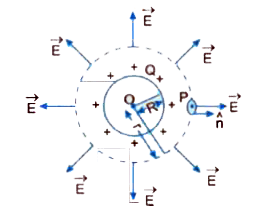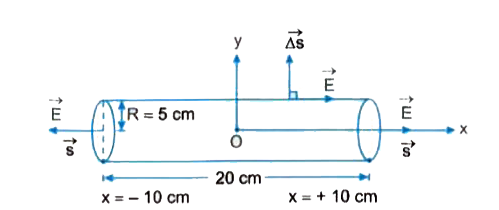Saved Bookmarks
| 1. |
(a) Using Gauss law, derive expression for electric field due to a spherical shell a uniform charge distribution sigma and radius R at a point lying at a distance r from the centre of shell, such that (i) O lt r lt R, and (ii) r gt R. (b) An electric field is uniform and acts along +x direction in the region of positive x. It is also uniofrm with the same magnitude but acts in -x direction in the region of negative x. The value of the fleld is E= 200 N/C for xgt 0 and E=-200 N//C" for "x lt 0. A right circular cylinder of length 20 cm and radius 5 cm has its centre at the origin and its axis along the x-axis so that one flat face is at x =+ 10 cm and the other is at x=-10 cm. Find : (i) The net outward flux through the cylinder. (ii) The net change present inside the cylinder. |
|
Answer» Solution :(a) (i) Consider a hollow charged conducting sphere of radius R and having charge Q. To find electric field at a point P inside the shell, consider a sphere through point P and having centre O, i.e, r= OP `("where "O lt r lt R)` as the GAUSSIAN surface. The electric flux through the Gaussian surface `phi_(E)=oint vecE. hatn ds=E 4pi r^(2) ....(i)` According to Gauss theorem, total electric flux should be `phi_(E)=(1)/(epsi_(0)) ("charged enclosed")=0` Thus, `phi_(E)=E.4pi r^(2)=0` [Since the Gaussian surface is not enclosing any charge) Thus,`phi_(E)=E.4 pi r^(2)=0` `rArr E=0`  (ii) To find electric field intensity at a point Poutside the shell situated at a distance `r (r gt R)` from the centre of shell, consider a sphere of radius r as the Gaussian surface. All points on this surface are equivalent relative to given charged shell and, thus, electric field E at all points of Gaussian surface has same magnitude E and `vecE` and i are parallel to each other. Total electric flux over the Gaussian surface `phi_(E)=oint vecE. hatn dx=E.4pir^(2) ......(i)`  According to Gauss.s theorem, `phi_(E)=1/in_(0) ("charged enclosed")=Q/(in_(0))` ........(ii) Comparing (i) and (ii), we get `E.4pi r^(2)=Q/in_(0) or E=Q/(4pi in_(0) r^(2))` If surface charge DENSITY of shell be `sigma" then Q"=4piR^(2), sigma` and therefore `E=(4piR^(2) sigma)/(4pi in_(0) r^(2))=(sigmaR^(2))/(in r^(2))` (B) The situation is shown in the given figure. Here, `E=200 NC^(-1)` length of cylinder l=20cm, 0.2m, radius of cylinder R=5cm, =0.05m (i) As shown in figure the net OUTWARD electric flux is along x-axis and HASA value `phi_(E)=2E triangles` `=2EpiR^(2)` `=2 xx 200 xx 3.14 xx (0.05)^(2)` `=3.14 Nm^(2) C^(-1)` (ii) As per Gauss law, net charge present inside the cylinder `q=in_(0) xx phi_(E)=(8.854 xx 10^(-12))xx 3.14 =2.78 xx 10^(-11) C` 
|
|
Discussion
No Comment Found
Related InterviewSolutions
- A wire is bent to form a semicircle of the radius a. The wire rotates about its one end with angular velocity omega . Axis of rotation is perpendicular to the plane of the semicircle . In the space , a uniform magnetic field of induction B exists along the aixs of rotation as shown in the figure . Then -
- A massless non conducting rod AB of length 2l is placed in uniform time varying magnetic field confined in a cylindrical region of radius (R gt l) as shown in the figure. The center of the rod coincides with the centre of the cylin- drical region. The rod can freely rotate in the plane of the Figure about an axis coinciding with the axis of the cylinder. Two particles, each of mass m and charge q are attached to the ends A and B of the rod. The time varying magnetic field in this cylindrical region is given by B = B_(0) [1-(t)/(2)] where B_(0) is a constant. The field is switched on at time t = 0. Consider B_(0) = 100T, l = 4 cm(q)/(m) = (4pi)/(100) C//kg. Calculate the time in which the rod will reach position CD shown in the figure for th first time. Will end A be at C or D at this instant ?
- A concave lens with equal radius of curvature both sides has a focal length of 12 cm. The refractive index of the lens is 1.5. How will the focal length of the lens change if it is immersed in the liquid of refractive index 1.8 ?
- If the tempearture of black body is raised by 5%, the heat energy radiated would increases by :
- What are the co-ordinates of the image of S formed by a plane mirror as shown in figure?
- The direction of ray of light incident on a concave mirror is shown by PQ in Fig. The direction in which the ray would travel after reflection is shown by four rays marked 1, 2, 3 and 4. Which of the four rays correctly shows the direction of reflected ray?
- What is meant by polarisation ?
- Two concentric coils each of radius equal to 2πcm are placed right angles to each other. If 3 A and 4 A are the currents flowing through the two coils respectively. The magnetic induction( in Wb m^(-2) )at the center of the coils will be
- Assertion: Out of ""_(1)He^(3) and ""_(7)He^(3), the binding energy of ""_(1)He^(3)is greater than ""_(2)He^(8). Reason: Inside the nucleus of""_(1)H^(3), there is more repulsion than inside the nucleus of ""_(2)He^(4).
- In which accelerated motion, K.E of the particle is constant